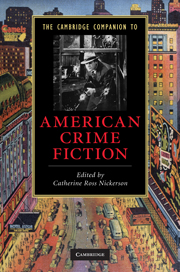Book contents
- Frontmatter
- 1 Introduction: The satisfactions of murder
- 2 Early American crime writing
- 3 Poe and the origins of detective fiction
- 4 Women writers before 1960
- 5 The hard-boiled novel
- 6 The American roman noir
- 7 Teenage detectives and teenage delinquents
- 8 American spy fiction
- 9 The police procedural in literature and on television
- 10 Mafia stories and the American gangster
- 11 True crime
- 12 Race and American crime fiction
- 13 Feminist crime fiction
- 14 Crime in postmodernist fiction
- Guide to reading
- Index
4 - Women writers before 1960
Published online by Cambridge University Press: 28 September 2010
- Frontmatter
- 1 Introduction: The satisfactions of murder
- 2 Early American crime writing
- 3 Poe and the origins of detective fiction
- 4 Women writers before 1960
- 5 The hard-boiled novel
- 6 The American roman noir
- 7 Teenage detectives and teenage delinquents
- 8 American spy fiction
- 9 The police procedural in literature and on television
- 10 Mafia stories and the American gangster
- 11 True crime
- 12 Race and American crime fiction
- 13 Feminist crime fiction
- 14 Crime in postmodernist fiction
- Guide to reading
- Index
Summary
For most, if not all, of the twentieth century, a consensus has existed among fans, collectors and critics of detective fiction about its development in the United States. The origin is in Edgar Allan Poe's “tales of ratiocination” of the early 1840s. There follows a long dry spell, a “fallow” period of about fifty years until Sherlock Holmes takes America by storm, and inspires some famous but ultimately minor writers (such as Jacques Futrelle). Between the 1890s and the 1920s, the real action is in Great Britain, where a “golden age” of tightly woven puzzles and country houses full of amusing guests is presided over by Agatha Christie and imitated by Americans like S. S. Van Dine. American detective fiction only comes into its own with the emergence of the hard-boiled style out of the “pulps” in the 1920s. In rebellion against a British style that seemed contrived and dull, Dashiell Hammett and Raymond Chandler produced something quintessentially American, like jazz. The iconic American detective novel is an improvisation on the themes the early hard-boiled writers laid out: urban settings, conspiracies among thugs and powerful men, deceptive women, and an underlying pessimism about human nature and American society.
- Type
- Chapter
- Information
- The Cambridge Companion to American Crime Fiction , pp. 29 - 41Publisher: Cambridge University PressPrint publication year: 2010
- 13
- Cited by

